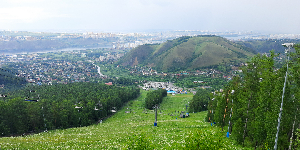Geography. The region is located in Asian Russia, in the southeast of the West Siberian Plain. It borders the regions of Russia such as the Omsk, Tyumen, Kemerovo, Novosibirsk Regions, the Khanty-Mansi Autonomous Area, and the Krasnoyarsk Territory. The region stretches for around 600 km from north to south and for 780 km from west to east. The area is 314,391 km². The better half of the territory is occupied by hard-to-reach taiga.
Climate. The climate is humid and continental in the south of the region and subarctic in the north.
Temperature
- -5 … -25˚C in winter
- +10 … +25˚C in summer
Population
Economy. The main industries are extraction and primary processing of raw hydrocarbons, the agricultural industry. The region actively develops the areas of new economy: nanotechnology, biotechnology, information technology, and others.
Logistics.
- The region’s territory is crossed by the federal road (М53) and federal highways (Р398, Р399, Р400). The Northern Latitudinal Highway, which is supposed to join the cities of North Urals and Western Siberia, is under construction.
- The main railway station in Tomsk is Tomsk 1.
- Bogashevo International Airport is located 14 km to the southeast of Tomsk, the capital of the region.
Tourist attractions
- Semiluzhki Cossack Ostrog (stockaded town) is located in the place where the Cossack outpost was situated in the 17th century. Local resident Vladimir Ilyin reconstructed on his own all the buildings of that time: fortress walls, towers with bells, peasant houses, a church, a blacksmith's shop, water wells, cannons as well as peasant household items. The ostrog holds tours familiarizing visitors with the architecture of the Cossack settlement and traditions of the Russian people as well as various master classes, wedding rites, and folk art festivals.
- Lake Mirnoe is the largest lake in the Tomsk Region. The lake area is more than 18 km², and its maximum depth is 4 m. From all sides, the lake is surrounded by swamps and taiga. Along its shores, there are mineral springs, beaches fitted out for recreation, and fishing docks. Rare fish species such as whitefish and European cisco can be found here.
- Vasyugan swamps are the world’s largest swamp system participating in controlling the Earth’s climate. It emerged approximately 10, 000 years ago. The system area is more than 53,000 km², and it increases by 8 km² every year. One of the world’s largest peat deposits is located here.
The capital is the city of Tomsk, founded in 1604. Today it is one of the important scientific and educational centers in Russia, aimed at developing knowledge-intensive industries. It is a member of the Asian Network of Major Cities.
Population
In Tomsk, there are several dozens of entertainment centers and movie theaters, 8 theaters, a philharmonic with an organ hall, night clubs, more than 30 museums, and a planetarium.









